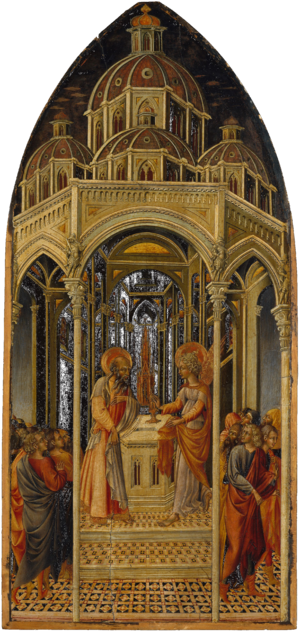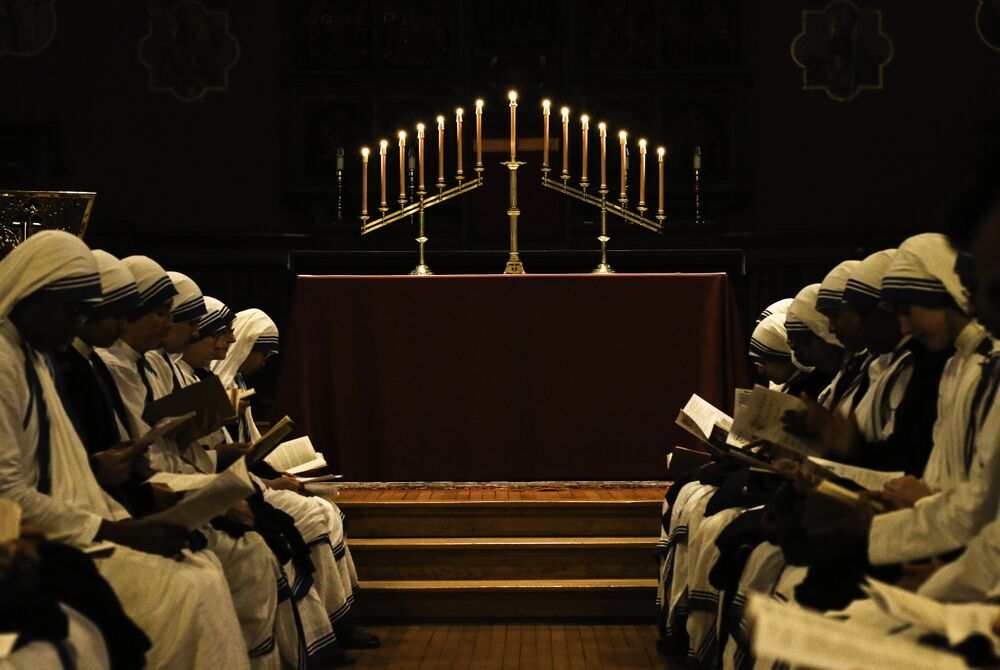Theatre by Firelight
Candles and oil lamps
Candles and oil lamps were everyday light sources for the people of the Middle Ages, but used en masse, together with staging and other effects, their use in religious performances was highly spectacular and powerfully symbolic.
The use of open fires in the form of bonfires and torches goes back to human pre-history, both to light up the night outdoors for celebrations and rites, and to provide light indoors for more mundane activities. The use of candles is evidenced in archaeological findings from around 500 BCE, while oil lamps, fuelled by oils from seeds, nuts and animal fats, are far older, dating from at least as far back as 10,000 BCE. Oil lamps came in a variety of sizes and designs, but all consisted of a container for the oil, a handle for carrying the lamp and a mouth where the wick to be lit could be dipped into the oil. The brightness of oil lamps and candles is limited by the small size of the flame, so while a single light source is adequate for a small room, a large space must be lit by many. While an oil lamp normally has only one wick, even in ancient times there were oil lamps with several wicks. There are examples from Crete of oil lamps with forty wicks to provide a very strong light source to illuminate a large room.
The religious plays of the Middle Ages performed in churches were the first examples of stage lighting – the first indoor performances that needed to be lit by candles and oil lamps. Even at the beginning, such lighting was not only a practical matter of illumination so that the performance could be seen. Light was central to the metaphysics of the Christian faith: God created the light that is manifested in the angels, in the divine grace, and – finally – as optical light. The very matter of the world was ordered in its value according to its degree of luminosity, so the four elements were, in order of precedence, fire, air, water, earth. The colours too were ordered according to their luminosity.
Church services were similarly structured by symbolic light. In the Tenebrae ceremony at Easter, the candles of a candelabra with many branches were extinguished one by one, as a symbol of the death of Christ, all except the highest one which was left burning. Around 970, Bishop Aethelwold wrote in Concordia Regularis that when the symbol of the resurrection, the Vernicle, is shown to the congregation, the church is ablaze with light. Like the resurrection, the birth of Christ was understood as a victory of light over darkness. The star of Bethlehem was portrayed as moving overhead, along the gallery of the church, while the Virgin Mary carried a symbolic candle.
The Russian Bishop Abraham of Suzdal described performances of the Annunciation and the Ascension in churches in Florence in the 15th century (Q287), in which light played a central role. In the Annunciation, the figure of God sat on a raised platform at the West end of the nave. Seven concentric circles, the smallest 4 feet in diameter, surrounded the throne, supporting a total of 1000 burning oil lamps, representing the celestial orbits of creation. Opposite this representation of paradise, 175 feet away at the other end of the nave, sat Mary, also on a raised platform. When the moment of the annunciation reached, the Angel Gabriel flew on a ropeway from Paradise to Mary, over the heads of the audience. After the annunciation dialogue, Suzdal describes a ray of fire, filling the church with sparks, travelling out from God towards Mary and back again, which ‘lights the candles in the church but without damaging the clothes of the spectators or causing any other harm’. Gabriel flies back to Paradise, the ray is extinguished, and the two platforms surrounded by curtains again, hiding God and Mary from view.
Suzdal also describes a performance of the Ascension. A platform was constructed the width of the church – 140 feet – with at one side a stone structure to represent Jerusalem, and on the other a cliff to represent the Mount of Olives. At a height of 56 feet above the mount, a large platform represented Paradise, painted like the sky, with a central opening covered by a cloth with sun, stars and moon on it. When the cloth was pulled aside, God was revealed, illuminated by many candles and looking down on Christ, Mary and the apostles below. For the ascension itself, a cloud and two angels were lowered from Paradise, and Jesus was lifted up until he ascended into the cloud. At that point, the cloud was lit up from within by many candles, and rose again, carrying Christ up to Heaven.
Light was central to the Christian understanding of the world in the Middle Ages, and was therefore central to the religious performances that took place in churches at that time. Candles and oil lamps were in everyday use, but they were expensive. The use of large quantities of light sources with pyrotechnic and luminous effects would have been a rare sight, both impressively spectacular and of deep symbolic meaning to the audiences of the time. We can consider these religious performances to be the first examples of lighting design, the massed flames of candles and oil lamps making an impact as great as any design since.

